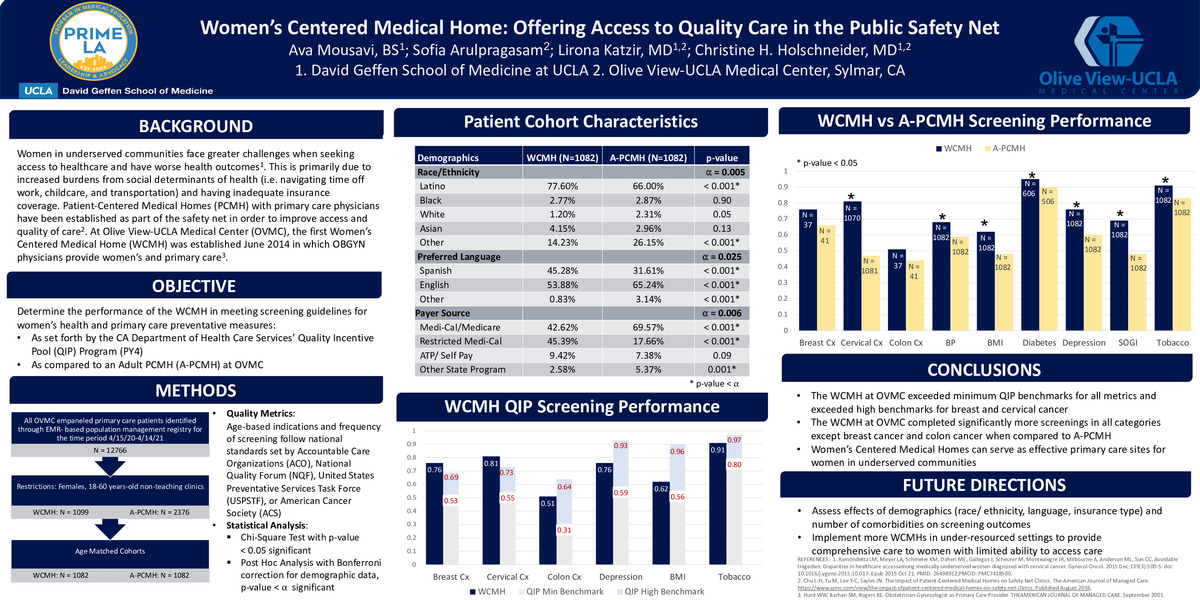-
Author
Ava Mousavi -
PI
Lirona Katzir, MD
-
Co-Author
Christine H. Holschneider, MD
-
Title
Women’s Centered Medical Home: Offering Access to Quality Care in the Public Safety Net
-
Program
STTP
-
Other Program (if not listed above)
-
Abstract
Background: Previous studies have shown that women in underserved communities face greater challenges when seeking access to healthcare and have worse health outcomes. This is primarily due to increased burdens from social determinants of health (i.e. navigating time off work, childcare, and transportation) and having inadequate insurance coverage. Patient-Centered Medical Homes (PCMH) with Internal Medicine and Family Medicine physicians have been established to provide primary care services as part of the safety net. The main tenets of a PCMH are to provide comprehensive, patient-centered, coordinated, accessible, and quality care. At Olive View-UCLA Medical Center (OVMC), there are two PCMHs that follow the traditional primary care PCMH model. The novel concept of a Women’s Centered Medical Home (WCMH) was piloted at OVMC in June 2014 in which OBGYN physicians provide both specialty and primary care in order to provide continuous healthcare across a woman’s reproductive life.
Objective: Determine the performance of the WCMH in meeting screening guidelines for women’s health and primary care preventative measures as set forth by the CA Department of Health Care Services’ Quality Incentive Pool (QIP) Program (PY4) and as compared to an Adult PCMH (A-PCMH) at OVMC.
Methods: All empaneled OVMC primary care patients were identified through EMR- based population management registry for the time period 4/15/20-4/14/21. After restricting the sample to 18-60 year old females who were empaneled to non-teaching clinics, we had 1099 WCMH patients and 2376 A-PCMH patients. We further reduced our sample size by age-matching the groups. Completion of each health screening was recorded from the patient chart. Age-based indications and frequency of screening followed national standards set by Accountable Care Organizations (ACO), National Quality Forum (NQF), United States Preventative Services Task Force (USPSTF), or American Cancer Society (ACS). Data was analyzed using Chi-square tests with p-value < 0.05 considered significant. Further Post Hoc Analysis with Bonferroni correction was performed for demographic data, with p-value < ⍺ considered significant.
Results: The WCMH has significantly more (p-value < 0.001) patients that identify as Latino, have preferred language as Spanish, and who use restricted scope Medi-Cal as compared to the A-PCMH. The WCMH at OVMC has exceeded minimum QIP benchmarks for all metrics and exceeded high benchmarks for breast and cervical cancer. When compared to the Adult PCMH at Olive View, we found that the WCMH’s performance was non-inferior. The WCMH at OVMC completed significantly more (p-value < 0.001) health screenings in most screening categories (cervical cancer, blood pressure, BMI, diabetes, depression, sexual orientation/gender identity, and tobacco). However, there was not a signficant difference in breast cancer (p-value= 0.51) and colon cancer (p-value= 0.342) screening completion between the two clinics.
Conclusions: As shown by the significant performance of WCMH healthcare screening guidelines as compared to QIP benchmarks and the Adult PCMH, Women’s Centered Medical Homes can serve as effective primary care sites for female patients whose healthcare needs are best met by an OBGYN.
Future Directions: Assess the effects of demographics (race/ethnicity, language, insurance type) and number of comorbidities on screening outcomes through logistic regression analysis. Assess when the patient’s last in-person visit occurred. Advocate for more WCMHs to be incorporated in under-resourced settings in order to provide comprehensive care to women with limited ability to access care.
-
PDF
-
Zoom

